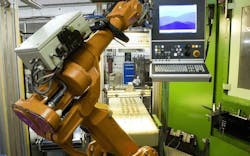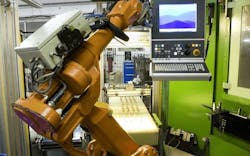Industry 4.0 Finds New Synergies with a Combination of Diverse Technologies (.PDF Download)
When talking about the history of technology, it’s common to group manufacturing operations into four loosely defined “industrial revolutions” that gradually replaced human- and horse-power with increasing levels of mechanization. The first stage of mechanization relied on power from water and steam; stage two introduced electrical power, mass production, and the assembly line; and computers and automation characterized stage three.
We’re now well into the fourth stage, often called Industry 4.0. It builds on stage three by adding robotic technologies, massive data-gathering courtesy of Internet of Things (IoT) technology, and cloud computing with machine learning and artificial intelligence (AI) (Fig. 1).
1. Typical Industry 4.0 elements include a robot, an HMI, machine vision, and a sophisticated communication network. (Source: TI Applications: Factory Automation & Control)
In manufacturing, Industry 4.0 is synonymous with the smart factory, in which automated systems make decisions about local processes, communicate and cooperate with each other, and interact with human operators in real-time both in the factory and in the cloud.

